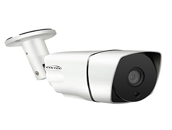
By Christopher Bergey
Vice President of Embedded and Integrated Solutions, Western Digital Corporation
 Security cameras represent a large global market driven primarily by the increased adoption of video surveillance systems for business or public-sector intelligence, and rising threats associated with public safety. As such, surveillance cameras are now common in and around government buildings, military posts, businesses, banks, transportation centers, casinos, shopping malls, sports venues, historic landmarks, schools, and many more.
Security cameras represent a large global market driven primarily by the increased adoption of video surveillance systems for business or public-sector intelligence, and rising threats associated with public safety. As such, surveillance cameras are now common in and around government buildings, military posts, businesses, banks, transportation centers, casinos, shopping malls, sports venues, historic landmarks, schools, and many more.
Surveillance isn’t just about security any longer, but in many cases, it’s about extracting value and intelligence from the video captured. This could include retail shopper behaviors, or in managing a parking facility, or when producing manufactured products. Seeing a drone flying through the air capturing images and video nowadays from a construction site or farmland is no longer unusual.
As such, the video surveillance market is experiencing burgeoning growth, and as of 2016, was valued at over US$30 billion, with expectations of reaching US$75 billion in revenue by 2022, at a CAGR of 15.4 percent from 2017 to 2022. What has changed in surveillance is not how data is captured, but how it can be used to drive actions, not only as part of a Fast Data application that analyses data as it is captured, but also as part of a Big Data application that analyses data when required. It’s no longer about just storing data, but what we can do with it once captured that is fueling a new generation of ‘smart’ video applications.
What is Smart Video?
Smart video is about this shift from imagery to insights, from simply collecting data for forensic and backwards-viewing, to analysing and understanding the context of the data captured. It uses artificial intelligence (AI) and algorithms derived from Big Data to provide immediate insights and forward-looking predictions.
These Fast Data examples include:
- Parking space management where analytics can be used to determine peak hours of operation, handicap parking use, areas of congestion, average parking durations, and unmoved vehicles.
- Machine production analytics can be used to determine yields produced, failures that occurred or about to occur, machine issues and inefficiencies, upcoming maintenance, and peak hours of operation.
- Customer retail buying preferences where analytics can be used to determine how many people entered the store, their gender and ages, in-store time spent, average spend, and traffic generated by the new kiosk.
- Agricultural drone surveillance where analytics can be used to survey a farm and surrounding land, diagnose vegetation and crop health, determine possible yields, track livestock and food consumption, as well as insect and pest populations.
- Smart city scenarios where analytics can be used to provide safety and evacuation information, and can coordinate with weather and traffic data to create the fastest evacuation routes out of a city.
The need to provide intelligent capabilities within video surveillance, coupled with the development of cloud-based surveillance systems, has led to the evolution of a smart breed of cameras at the network’s edge. These edge-based cameras have a powerful computing element and capable storage device implemented within that enables local capture and analysis (where the data is generated and lives), providing the valuable insights in real-time, without the effects of network availability or latency.
Sample Use-Case
Authorities are looking for a missing senior citizen with mental incapacities who may need help. They believe he entered a store and left. In a Big Data application, someone would have to review tons of captured video, looking backwards to find evidence of this lost soul in the store, and possibly perform some additional analysis on the data to determine his actions, identify the time he entered or left the store, and take some action. In this example, Big Data analysis is performed after the event has occurred.
Utilising AI and algorithms from Big Data, Fast Data responds to events as they occur. Once the senior citizen enters the store, a Fast Data app can perform real-time facial recognition from the video feed, comparing the senior’s face to a database library of facial signatures. If the facial signature is detected, the application can trigger a security alert to help the senior in distress and get him back to his family safely.
The Data Storage Strategy
As Big Data gets bigger and faster, and Fast Data gets faster and bigger, the storage strategy is to not funnel all of the video content to the main server, which is expensive and dependent on network availability, but instead, use a combination that stores data locally at the camera-level, as well as an edge gateway that enables video and data to be aggregated at various distances from the edge, and back to the cloud where Big Data content typically resides. A video surveillance system that uses edge cameras and this storage strategy, will reap high system and service reliability, low TCO, and the ability to scale without adding expensive recorders or servers to the surveillance system.
Final Thoughts
Fast Data applications for smart video are endless and have only scratched the surface of real-world use. We amass and generate large amounts of information from the increasing number of data points captured by such edge devices as surveillance cameras. Applying analytics to real time captured data is driving new smart video applications whose video streams extract value and intelligence that drive actionable insights.
Author’s Bio:
Christopher Bergey
 Christopher Bergey is responsible for developing and driving Western Digital’s embedded storage solution strategies in the mobile and connected market segments, including smartphones and tablets, automotive, industrial, connected home and other connected, “Internet of Things” environments. Prior to joining Western Digital, Mr. Bergey served in senior management and marketing roles for Luxtera, Broadcom, Multilink Technology Corporation and Advanced Micro Devices. He received his MBA degree from the University of Maryland and Bachelor’s degree in Electrical and Computer Engineering from Drexel University. More information available at www.sandisk.com and www.wdc.com.
Christopher Bergey is responsible for developing and driving Western Digital’s embedded storage solution strategies in the mobile and connected market segments, including smartphones and tablets, automotive, industrial, connected home and other connected, “Internet of Things” environments. Prior to joining Western Digital, Mr. Bergey served in senior management and marketing roles for Luxtera, Broadcom, Multilink Technology Corporation and Advanced Micro Devices. He received his MBA degree from the University of Maryland and Bachelor’s degree in Electrical and Computer Engineering from Drexel University. More information available at www.sandisk.com and www.wdc.com.






